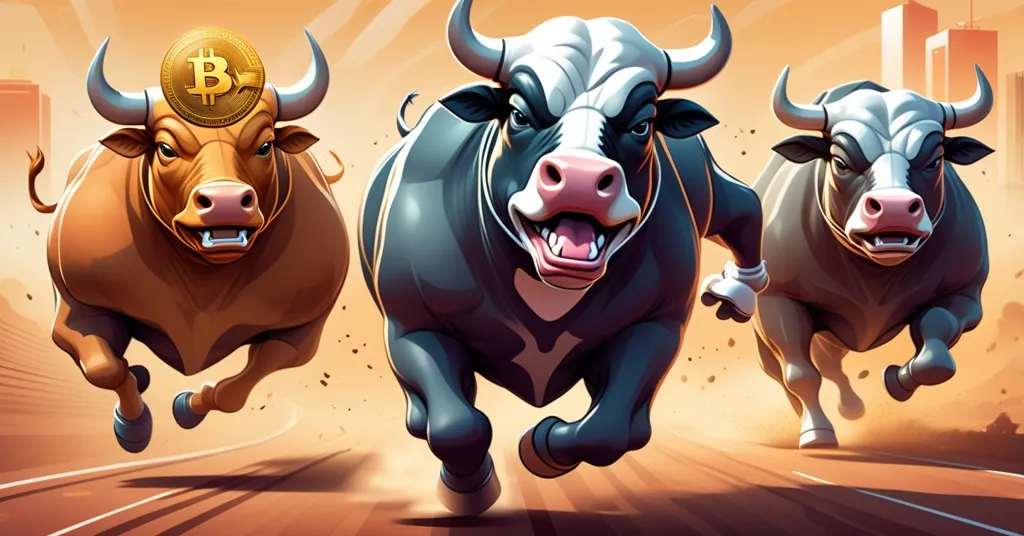Solana, Ripple, Mutuum Finance: Legit Contenders or Hype for 2025 Crypto Bull Run?

Solana, Ripple, and Mutuum Finance: Hype or Hope for the 2025 Crypto Bull Run?
As murmurs of a 2025 crypto bull run grow louder, investors are scrambling to pick the next big winners. Solana (SOL), Ripple (XRP), and the obscure Mutuum Finance (MUTM) are making waves as potential frontrunners, but separating genuine potential from slick marketing is no easy feat. Let’s cut through the noise and dissect what these projects offer—and what they might be hiding.
- Solana (SOL): Trading around $163, it’s a DeFi juggernaut with unmatched speed, but not without hiccups.
- Ripple (XRP): Sitting at $0.50–$0.60, it’s a stable player with real-world use, despite overblown price claims.
- Mutuum Finance (MUTM): A presale project boasting $9.7 million raised, but scam warnings are flashing red.
The Bigger Picture: What Fuels a 2025 Bull Run?
Before diving into specific projects, let’s set the stage. Crypto bull runs often follow predictable triggers, like Bitcoin’s halving cycles, where mining rewards are slashed—think of it as supply getting squeezed while demand often spikes. The 2024 halving dropped Bitcoin’s issuance to just 3.125 BTC per block, historically a recipe for price surges as seen in 2016 and 2020. Add to that macroeconomic shifts, like potential interest rate cuts in major economies, which could push investors toward riskier assets like crypto, and you’ve got a powder keg waiting for a spark. But it’s not all sunshine—regulatory crackdowns, economic instability, or even a Bitcoin dump could derail the hype train. With altcoins often riding Bitcoin’s coattails, any 2025 crypto surge will test which projects have real legs and which are just along for the ride. So, where do Solana, Ripple, and Mutuum Finance fit in this volatile puzzle?
Solana: Speed Demon or Crash Risk?
Is Solana the Ethereum killer everyone’s been waiting for, or just another blockchain set to buckle under its own ambition? Priced at roughly $163 as of late 2024, Solana has carved out a serious niche in decentralized finance (DeFi)—a term for financial apps on blockchain that ditch middlemen like banks. Its network can handle a blistering 65,000 transactions per second (TPS), dwarfing Ethereum’s sluggish pace, and does so at a fraction of the cost, with fees often under a penny. Data from Everstake’s 2024 Solana performance report paints a glowing picture: 100% uptime outside a minor 5-hour glitch in February, a peak of 120 million active addresses in October, and a jaw-dropping 138 million daily transactions by December—that’s like processing a small country’s payment volume every day.
Recent tech upgrades only sweeten the deal. Innovations like ZK Compression cut down on data storage needs, making operations cheaper for developers, while Token Extensions enable features like confidential transfers—think private transactions without shady vibes. Solana’s ecosystem is buzzing too, with platforms like Pump.fun, a meme coin launcher sparking viral trends (and plenty of junk tokens), pulling in $30.5 million in revenue in October alone. Raydium, a DeFi hub, handled $30 billion in trades the same month. These numbers scream growth, positioning Solana as a powerhouse for the 2025 bull run, as detailed in its technical overview on Wikipedia.
But let’s not chug the fanboy juice just yet. Solana’s had its share of stumbles—network outages during past demand spikes have exposed cracks in its scalability armor. If a bull run unleashes another frenzy of activity, will it hold up, or crash spectacularly? Community discussions on Solana’s scalability challenges highlight ongoing concerns. And with Ethereum’s own upgrades like sharding on the horizon, Solana’s speed edge might not last forever. It’s a strong bet for DeFi dominance, but not a flawless one.
Ripple: Corporate Crypto with Staying Power?
Ripple, or XRP, often feels like the buttoned-up cousin in the chaotic crypto family. Despite some wild claims floating around about it trading at $2.3 with a May peak of $2.60, let’s stick to reality—current market data pegs XRP at a far humbler $0.50–$0.60 range in late 2024. Price aside, its strength lies in utility, not speculation. Ripple’s tech is built for cross-border payments, zipping through over 1,500 TPS at a measly $0.0002 per transaction—compare that to SWIFT, the clunky old banking system, where fees and delays can bleed you dry. Targeting the $700 billion remittance market, XRP powers Ripple’s On-Demand Liquidity (ODL) system, offering real-time settlements that could revolutionize money movement, especially for folks in developing economies sending cash home, as explored in discussions on XRP’s payment efficiency.
With partnerships spanning over 300 financial institutions across 40+ countries, Ripple has the kind of institutional backing most altcoins can only dream of. A pivotal win came in October 2024 when its long-running SEC lawsuit in the U.S. wrapped up, with XRP ruled a non-security for exchange sales—a rare stamp of regulatory clarity in a space often mired in legal gray zones, with further insights available in updates on Ripple’s legal battle. As Ripple CEO Brad Garlinghouse puts it:
“Ripple is about transforming how the world moves money.”
Yet, before you crown XRP the safe bet, consider the headwinds. While the U.S. ruling is a boost, global regulatory landscapes are still a patchwork mess—some countries could slap bans or restrictions overnight. Competition looms too; Stellar (XLM) chases the same payment niche, and even SWIFT is modernizing with faster systems. Plus, the rise of Central Bank Digital Currencies (CBDCs) could render XRP’s middleman-killing mission obsolete if governments roll out their own digital cash. XRP offers grounded value, but it’s no guaranteed moonshot in a market often drunk on reckless hype.
Mutuum Finance: Dream or Deception?
Now for the wildcard—Mutuum Finance, or MUTM, a DeFi newcomer with a hype machine cranked to eleven. Promotional buzz claims it’s raised over $9.7 million in presale from nearly 11,500 investors at a dirt-cheap $0.03 per token, with a launch price of $0.06 promising a tidy 100% profit for early buyers. They’re even tossing out a $100,000 token giveaway as bait—ten lucky folks supposedly snag $10,000 worth of MUTM each. The pitch? A hybrid lending model blending Peer-to-Contract (P2C) and Peer-to-Peer (P2P) systems. To break it down, P2C lets you lock stablecoins like USDT into automated smart contract pools for passive income—think of it as a high-tech savings account. P2P, meanwhile, is like lending directly to a buddy, negotiating terms without a bank breathing down your neck. Hosted on Ethereum, with a planned USD-pegged stablecoin to avoid nasty depeg dramas, and allegedly backed by a Certik audit for security, it sounds like DeFi’s next shiny toy, as hyped in some bullish crypto forecasts.
But hold your horses—this reeks of classic scam stench. There’s zero independent proof of that $9.7 million haul or the Certik stamp. No on-chain data, no accessible whitepaper beyond glossy ads, and community chatter on Reddit’s r/CryptoScams screams fraud, with users pointing to videos alleging outright deception, as seen in posts questioning Mutuum Finance’s legitimacy. One anonymous post summed it up: “No transparency, no team faces, just empty promises—run.” In a space littered with rug pulls—where devs hype a project, grab the cash, and vanish—MUTM’s glow feels more like a warning flare. Sure, if they somehow deliver a transparent audit and a working product, I’ll eat my hardware wallet. Until then, this smells like another DeFi disaster waiting to fleece FOMO-chasers.
For context, presale scams are a dime a dozen in crypto. They bank on retail investors desperate for quick gains, often using giveaways and inflated “returns” as lures. Real red flags to watch? Hidden teams, unverifiable funds, and no clear roadmap. If you’re tempted by MUTM or any presale, dig into on-chain activity via tools like Etherscan, demand team accountability, and never invest what you can’t afford to lose. Hype doesn’t equal value—hard proof does.
Bitcoin’s Shadow: Do Altcoins Even Matter?
As a Bitcoin maximalist at heart, I can’t help but question why we’re even chasing altcoin glitter when BTC remains the undisputed king of decentralization—a true store of value immune to the whims of shady devs or corporate agendas. Bitcoin’s halving-driven scarcity and battle-tested network make it the anchor of any bull run, often dragging altcoins up (or down) with it. So why bother with Solana’s congestion risks, XRP’s regulatory tightrope, or MUTM’s blatant question marks? The counterargument holds some water, though—altcoins often tackle niches Bitcoin ignores. Solana’s speed fuels dApps and DeFi in ways BTC never will; XRP’s payment rails target real-world gaps; even MUTM, if legit, could innovate lending. The catch is discerning which altcoins are genuine disruptors and which are just noise. In a 2025 surge, Bitcoin’s dominance might overshadow speculative plays—but it won’t kill the hunger for specialized innovation.
Key Takeaways and Questions to Ponder
- Why is Solana (SOL) a contender for the 2025 bull run?
Its scalability, with 65,000 TPS and low fees, plus DeFi traction—think 138 million daily transactions at peak—make it a heavyweight. But past outages hint at risks under heavy load. - What makes Ripple (XRP) a safer play despite modest pricing?
Real utility in cross-border payments, 300+ institutional partners, and U.S. regulatory clarity give it legs. Still, global rules and rivals like Stellar or CBDCs could cap its upside. - Should you buy into Mutuum Finance (MUTM) presale hype?
Hell no, not without ironclad proof. Unverified claims of $9.7 million raised and scam warnings on forums scream danger. Check on-chain data and team creds before even blinking at it. - Are presale coins generally worth the gamble for big returns?
Rarely. Most are speculative traps—history shows countless DeFi rug pulls where investors lose everything. Stick to projects with proven impact over marketed “moonshots.” - Does Bitcoin’s strength outshine these altcoin picks?
Partly. BTC’s reliability as decentralized money trumps unproven ventures like MUTM, but Solana and XRP fill gaps in DeFi and payments that Bitcoin doesn’t aim to address.
Peering into the 2025 bull run horizon, the crypto market remains a wild west of promise and peril. Solana dazzles with tech and traction, though it’s not immune to stumbles. Ripple offers a rare blend of utility and stability, even if it won’t fuel your Lambo dreams. Mutuum Finance, frankly, looks like a dumpster fire until hard evidence says otherwise. As advocates for decentralization and shaking up the status quo, we cheer for innovation—but not blind stupidity. Do the grunt work, question every claim, and remember: in crypto, greed often burns faster than gains. The future of finance is ours to build, so let’s bet on substance over snake oil.



